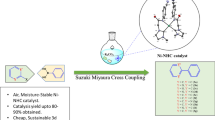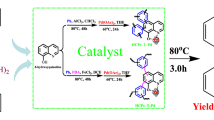Abstract
Transition metal hydrides play important roles in organometallic catalysis and synthetic reactions. Metallocenes niobium or tantalum hydride derivatives show high reactivities with variety of main group 13 Lewis acids. In this work, the nature of MH···B/Al interaction between Cp2M(L)H(M = V, Nb, and Ta) and BF3/AlF3 in 1:1 Lewis acid–base adducts as well as the influences of different types of ligands on the interactions is investigated. The results show that in Cp2M(L)H···BF3/AlF3, the MH···B interaction belongs to covalent interaction, and MH···Al shows partly covalent character. The covalent character of MH···B/Al bonds decreases with the increasing period of metal atom. The strength of MH···B/Al interaction is related to the type of metal atom (M) and ligand (L) in Cp2M(L)H, and the influences of L are larger than those of M. For the same M, the strength of MH···B/Al bonds is mainly influenced by the type of ligand, and they increase in the sequence of L = CO, C2H4, and P(CH3)3. The formation of Cp2M(L)H···BF3/AlF3 increases the polarity of M–H bond of Cp2M(L)H.




Similar content being viewed by others
References
Choukroun R, Lorber C, Vendier L, Lepetit C (2006) Vanadocene-mediated ionization of water in the aqua species [H2O·B(C6F5)3]: structural characterization of the hydride and hydroxide complexes [Cp2V(μ-H)B(C6F5)3] and [Cp2V(μ-OH)B(C6F5)3]. Organometallics 25(7):1551–1553
Norton JR, Sowa J (2016) Introduction: metal hydrides. Chem Rev 116(15):8315–8317
Rossin A, Peruzzini M (2016) Ammonia-borane and amine-borane dehydrogenation mediated by complex metal hydrides. Chem Rev 116(15):8848–8872
Esteruelas MA, Lopez AM, Olivan M (2016) Polyhydrides of platinum group metals: nonclassical interactions and σ-bond activation reactions. Chem Rev 116(15):8770–8847
Cook TR, Dogutan DK, Reece SY, Surendranath Y, Teets TS, Nocera DG (2010) Solar energy supply and storage for the legacy and nonlegacy worlds. Chem Rev 110:6474–6502
Appel AM, Bercaw JE, Bocarsly AB, Dobbek H, DuBois DL, Dupuis M, Ferry JG, Fujita E, Hille R, Kenis PJA, Kerfeld CA, Morris RH, Peden CHF, Portis AR, Ragsdale SW, Rauchfuss TB, Reek JNH, Seefeldt LC, Thauer RK, Waldrop GL (2013) Frontiers, opportunities, and challenges in biochemical and chemical catalysis of CO2 fixation. Chem Rev 113(8):6621–6658
Tapeinos IG, Koussios S, Groves RM (2016) Design and analysis of a multi-cell subscale tank for liquid hydrogen storage. Int J Hydrogen Enegy 41(5):3676–3688
Sakamoto J, Nakayama J, Nakarai T, Kasai N, Shibutani T, Miyake A (2016) Effect of gasoline pool fire on liquid hydrogen storage tank in hybrid hydrogen–gasoline fueling station. Int J Hydrogen Energy 41(3):2096–2104
Georgii IN, Sergei FV, Lyudmila GK, Judith AKH (2002) Serendipitous syntheses and structures of Cp2Nb(H){(SiMe2)2(μ-NR)}]. Chem Commun 6:568–569
Antiñolo A, Carrillo-Hermosilla F, Fajardo M, Fernández-Baeza J, García-Yuste S, Otero A (1999) Advances in the chemistry of bis-cyclopentadienyl hydride derivatives of niobium and tantalum. Chem Rev 193–195:43–72
Alonso-Moreno C, Antiñolo A, García-Martínez JC, García-Yuste S, López-Solera I, Otero A, Pérez-Flores JC, Tercero-Morales MT (2012) Molecular structure of a hydridoniobocene complex [Nb(η5-C5H4SiMe3)2(H)3] and its use as catalyst for the ring-opening polymerization of cyclic esters. Eur J Inorg Chem 2012:1139–1144
Antiñolo A, García-Yuste S, Otero A, Espinosa A (2015) Unusual mechanism for the reaction of a niobocene hydride complex with activated alkynes. Exp DFT Stud Organomet 34:2695–2698
Antiñolo A, Carrillo-Hermosilla F, Fajardo M, García-Yuste S, Lanfranchi M, Otero A, Pellinghelli MA, Prashar S, Villaseñor E (1996) Studies on the Insertion Reactions of Activated Alkynes into Nb-H Bonds in Hydride Niobocene Complexes. X-ray Crystal Structures of Nb(η5-C5H4SiMe3)2(H)[η2-RO2C(H) = C(H)CO2R] (R = Me or tBu). Organometallics 15:5507–5513
Antiñolo A, Carrillo F, Chaudret B, Fajardo M, Fernández-Baeza J, Lanfranchi M, Limbach HH, Maurer M, Otero A, Pellinghelli MA (1994) Synthesis, spectroscopic properties, and x-ray crystal structure of {[Nb(C5H3[SiMe3]2)2H3]2Au}+, a complex showing large quantum mechanical exchange couplings. Inorg Chem 33:5163–5164
Antiñolo A, Carrillo-Hermosilla F, Chaudret B, Fajardo M, Fernández-Baeza J, Lanfranchi M, Limbach HH, Maurer M, Otero A, Pellinghelli MA (1996) Exchange coupling in niobocene trihydrides, Nb(C5H3RR’)2H3, and their adducts with copper triad cations, [{Nb(C5H3RR’)2H3}2M]+ (R = R’ = H; R = H, R’ = SiMe3; R = R’ = SiMe3; M = Cu, Ag, Au). Inorg Chem 35:7873–7881
Tebbe FN (1993) Lewis acidic metal alkyl-transition metal complex interactions. I. Niobium and tantalum hydrides. J Am Chem Soc 95(16):5412–5414
Antiñolo A, Carrillo F, Fernández-Baeza J, Otero A, Fajardo M, Chaudret B (1992) Exchange couplings in lewis acid adducts of substituted niobiocene trihydrides. Inorg Chem 31:5156–5157
Braunschweig H, Wagner T (1996) Zur Umsetzung von Bis(η5-cyclopentadienyl)dihydridowolfram mit Halogenboranen. Z Naturforsch B 116(15):8873–8911
Maity A, Teets TS (2016) Main group lewis acid-mediated transformations of transition-metal hydride complexes. Chem Rev 116(15):8873–8911
Robert C, Christian L, Bruno D (2004) Zwitterionic, Ring-Borylated Vanadium(III) complexes from [Cp2VCO] and B(C6F5)3. Organometallics 23:1434–1437
Doerrer LH, Graham AJ, Haussinger D, Green MLH (2000) Electrophilic addition reactions of the Lewis acids B(C6F5)2R([R = C6F5, Ph, H or Cl) with the metallocene hydrides [M(η-C5H5)2H2] (M = Mo or W), [Re(η-C5H5)2H] and [Ta(η-C5H5)2H3]. J Chem Soc Dalton Trans 5:813–820
Amati M, Lelj F (2009) Bis(cyclopentadienyl)dihydrido Mo and W complexes as Lewis bases—a computational study about their adducts with BX3 (X = F, Cl) and Al(CH3)3. Can J Chem 87(10):1406–1414
Deckers PJW, Hessen B, Teuben JH (2001) Switching a catalyst system from ethene polymerization to ethene trimerization with a hemilabile ancillary ligand. Angew Chem Int Ed 40(13):2516–2519
Deckers PJW, Hessen B, Teuben JH (2002) Catalytic trimerization of ethene with highly active cyclopentadienyl-arene titanium catalysts. Organometallics 21(23):5122–5135
Camanyes S, Maseras F, Moreno M, Lledós A, Lluch JM, Bertrán J (1998) Theoretical study of the effect of a lewis acid on hydrogen exchange coupling in a trihydride metallocene: the Cp2NbH3·AlH3 system. Inorg Chem 37:2334–2339
Zhao Y, Truhlar DG (2006) A new local density functional for main-group thermochemistry, transition metal bonding, thermochemical kinetics, and noncovalent interactions. J Chem Phys 125(19):194101
Narendrapurapu BS, Richardson NA, Copan AV, Estep ML, Yang Z, Schaefer HF (2013) Investigating the effects of basis set on metal-metal and metal-ligand bond distances in stable transition metal carbonyls: performance of correlation consistent basis sets with 35 density functionals. J Chem Theory Comput 9(7):2930–2938
Xu X, Sun Z, Meng LP, Zheng SJ, Li XY (2019) A comparative study on the reaction mechanism of Cp2MH2 (M = Cr, Mo, W) with HBF4. Appl Organom Chem. 33:e4790
Dang YR, Wang WH, Meng LP, Li QZ, Li XY (2018) Nature of MoH···I bonds in Cp2Mo(L)H···I-C≡C-R Complexes (L = H, CN, PPh2, C(CH3)3; R = NO2, Cl, Br, H, OH, CH3, NH2). Appl Organom Chem. 32:4258
Han XW, Lv J, Meng LP, Li QZ, Li XY (2017) The ground and excited-state electronic structures of sandwich compounds Cp2(ME)2 contain an (ME)2 four-membered ring (Cp = C5H5; M = Ni, Pd, Pt; E = O, S, Se, Te) New. J. Chem. 41:12028–12034
Boys SF, Bernardi F (1970) The calculation of small molecular interactions by the differences of separate total energies. Some procedures with reduced errors. Mol Phys 19:553–566
Frisch MJ, Trucks GW, Schlegel HB, Scuseria GE, Robb MA, Cheeseman JR, Scalmani G, Barone V, Mennucci B, Petersson GA, Nakatsuji H, Caricato M, Li X, Hratchian HP, Izmaylov AF, Bloino J, Zheng G, Sonnenberg JL, Hada M, Ehara M, Toyota K, Fukuda R, Hasegawa J, Ishida M, Nakajima T, Honda Y, Kitao O, Nakai H, Vreven T, Montgomery JA Jr, Peralta JE, Ogliaro F, Bearpark M, Heyd JJ, Brothers E, Kudin KN, Staroverov VN, Kobayashi R, Normand J, Raghavachari K, Rendell A, Burant JC, Iyengar SS, Tomasi J, Cossi M, Rega N, Millam JM, Klene M, Knox JE, Cross JB, Bakken V, Adamo C, Jaramillo J, Gomperts R, Stratmann RE, Yazyev O, Austin AJ, Cammi R, Pomelli C, Ochterski JW, Martin RL, Morokuma K, Zakrzewski VG, Voth GA, Salvador P, Dannenberg JJ, Dapprich S, Daniels AD, Farkas O, Foresman JB, Ortiz JV, Cioslowski J, Fox DJ (2009) Gaussian 09 revision A.1. Gaussian Inc., Wallingford
Popelier P (2000) Atoms in molecules-an introduction. UMIST, Manchester
Bader RFW (1994) Atoms in molecules: a quantum theory. Oxford University Press, Oxford
Keith TA (2012) AIMALL, 13.02.26. http://aim.tkgristmill.com
Matito E, Silvi B, Duran M, Solà M (2006) Electron localization function at the correlated level. J Chem Phys 125:24301
Noury S, Krokidis X, Fuster F, Silvi B (1999) Computational tools for the electron localization function topological analysis. Comput Chem 23:597–604
Feixas F, Matito E, Duran M, Solà M, Silvi B (2010) Electron localization function at the correlated level: a natural orbital formulation. J Chem Theory Comput 6:2736–2742
ADF2008.01, SCM, Theoretical chemistry, Vrije Universiteit, Amsterdam, The Netherlands. http://www.scm.com
Bulat FA, Toro-Labbé A, Brinck T, Murray JS, Politzer P (2010) Quantitative analysis of molecular surfaces: areas, volumes, electrostatic potentials and average local ionization energies. J Mol Model 16:1679–1691
Politzer P, Burda JV, Concha MC, Lane P, Murray JS (2006) Analysis of the reaction force for a gas phase SN2 process: CH3Cl + H2O → CH3OH + HCl. J Phys Chem A 110:756–761
Alvarez S (2013) A cartography of the van der Waals territories. Dalton Trans 42:8617–8636
Cordero B, Gomez V, Platero-Prats AE, Reves M, Echeverria J, Cremades E, Barragan F, Alvarez S (2008) Covalent radii revisited. Dalton Trans 21:2832–2838
Lu T (2013) Multiwfn: a multifunctional wavefunction analyzer, version 3.0.1. http://Multiwfn.Codeplex.Com
Humphrey W, Dalke A, Schulten K (1996) VMD: visual molecular dynamics. J Mol Graphics 14:33–38
Silvi B, Savin A (1994) Classification of chemical bonds based on topological analysis of electron localization functions. Nature 371:683–686
Becke AD, Edgecombe KE (1990) A simple measure of electron localization in atomic and molecular systems. J Chem Phys 92(9):5397–5403
Silvi B (2002) The synaptic order: a key concept to understand multicenter bonding. J Mol Struct 614:3–10
Van der Maelen JF, Cabeza JA (2012) QTAIM analysis of the bonding in Mo-Mo bonded dimolybdenum complexes. Inorg Chem 51(13):7384–7391
Timerghazin QK, Rizvi I, Peslherbe GH (2011) Can a dipole-bound electron form a pseudo-atom? An atoms-in-molecules study of the hydrated electron. J Phys Chem A 115(45):13201–13209
Lu F, Li X, Sun Z, Zeng Y, Meng L (2015) Influences of the substituents on the M-M bonding in Cp4Al4 and Cp2M2X2 (M = B, Al, Ga; Cp = C5H5, X = halogen). Dalton Trans 44(31):14092–14100
Kar T, Ängyán JG, Sannigrahi AB (2000) Comparison of ab Initio Hartree-Fock and Kohn-Sham orbitals in the calculation of atomic charge, bond index, and valence. J Phys Chem A 104:9953–9963
Firme CL, Antunes OAC, Esteves PM (2009) Relation between bond order and delocalization index of QTAIM. Chem Phys Lett 468(4–6):129–133
Gernot F, Karin W, Nikolaus F, Christoph L, Matthias L, Jan F, Víctor MR (2003) Towards a rigorously defined quantum chemical analysis of the chemical bond in donor-acceptor complexes. Coord Chem Rev 238–239:55–82
Daniel S, Kristopher M, Christopher JC (2013) Thermochemical factors affecting the dehalogenation of aromatics. Environ Sci Technol 47:14194–14203
John PW, Daniel S, Kaitlin MB, Christopher JC, James AP (2014) Quantum chemical and matrix-IR characterization of CH3CN–BCl3: a complex with two distinct minima along the B-N bond potential. Phys Chem Chem Phys 16:16480–16491
Dapprich S, Frenking G (1995) Investigation of donor-acceptor interactions: a charge decomposition analysis using fragment molecular orbitals. J Phys Chem 99:9352–9362
Serge IG, Somdatta G, Edward IS (2006) Mechanism of N2O reduction by the μ4-S tetranuclear CuZ cluster of nitrous oxide reductase. J Am Chem Soc 128:278–290
Funding
This work was supported by the Education Department Foundation of Hebei Province (Contract No. ZD2018066) and Hebei Normal University Foundation (L2019Z03).
Author information
Authors and Affiliations
Corresponding author
Ethics declarations
Conflict of interest
The authors declare that they have no conflict of interest.
Additional information
Publisher's Note
Springer Nature remains neutral with regard to jurisdictional claims in published maps and institutional affiliations.
Electronic supplementary material
Below is the link to the electronic supplementary material.
Rights and permissions
About this article
Cite this article
Wang, J., Sun, Z., Li, Q. et al. Comparative study of 1:1 Lewis acid–base adducts between Cp2M(L)H (M = V, Nb, Ta; L = CO, C2H4, P(CH3)3) and BF3/AlF3. Theor Chem Acc 138, 104 (2019). https://doi.org/10.1007/s00214-019-2493-3
Received:
Accepted:
Published:
DOI: https://doi.org/10.1007/s00214-019-2493-3




